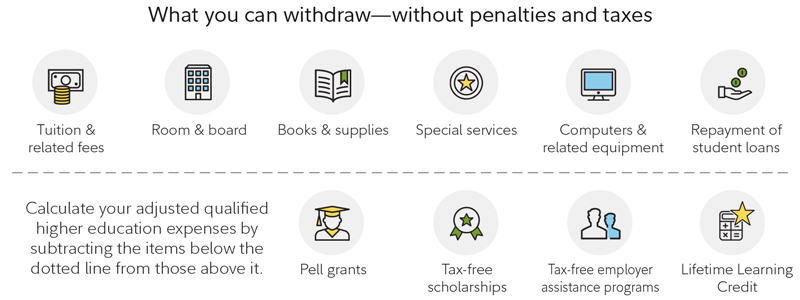How to spend from a 529 college plan
The right way helps reduce taxes, avoid penalties, and won't jeopardize financial aid.
- Withdrawals from 529 plans are not taxed at the federal level—as long as you understand and follow all the rules for qualifying expenses. You'll have to report your 529 plan spending to the IRS, so keeping careful records is important.
- Decide ahead of time how you'll withdraw the funds and use them.
- You'll also want to plan ahead for any tax credits you may qualify for, which could help you decide how much you need to take from your 529 account.
- 529 savings plans aren't just for college. You can spend up to $10,000 from a 529 plan on tuition expenses for elementary, middle, or high school.
Year after year, you and your child have been saving for college through a 529 savings account. Now college is closer and it's time to think about spending the money you've put aside. You'll be in control of how much is withdrawn and how it'll be used, but there are a few things you need to know up front to make the most of your savings.
First, a reminder about federal gift tax limits: In 2025, you can save up to $19,000 per parent in a 529 account, or $38,000 per couple. One set of grandparents can also contribute up to $38,000 as a couple, per beneficiary per year. Contributing more than $19,000 per beneficiary would need to be reported to the IRS as a gift. However, with "accelerated gifting,"2 a 529 account can be funded with contributions of $95,000 per person or $190,000 per couple—which uses up your federal gift-tax exclusion for 5 years.
What can you use this money for? Which expenses trigger taxes and penalties? If you do things right, no penalties or federal income tax—and, in many states, no state income tax—will be due on your withdrawals. But learning by trial and error can be costly at tax time, and more importantly, your child could lose out on financial aid if you're not careful. So learn the ins and outs ahead of time.
Here's a 9-step guide to help you make your 529 savings go as far as possible.
1. Plan for tax-free withdrawals
Qualified withdrawals are federal income tax-free so long as the total withdrawals for the year don't exceed your child's adjusted qualified higher education expenses (QHEEs), discussed in section #3 below.
To calculate these, add up tuition and fees, room and board, books and supplies, any school-related special services, and computer costs, and then deduct any costs already covered by tax-free educational assistance. Examples include Pell grants, tax-free scholarships and fellowships, tuition discounts, the Veteran's Educational Assistance Program, and tax-free employer educational assistance programs.
But you're not done yet. You'll also need to deduct costs used to claim an American Opportunity Tax Credit or Lifetime Learning Credit. The basic rule: You can't double up tax benefits for the same college expenses, discussed in section #5 below.

For full details, see footnote3
2. Know which expenses qualify
When you pay qualified education expenses from a 529 account, your withdrawals are tax- and penalty-free. As of 2019, qualified expenses include tuition expenses for elementary, middle, and high schools (private, public, or religious). Although the money may come from multiple 529 accounts, only $10,000 total can be spent each year per beneficiary on elementary, middle, or high school tuition.
Money saved in a 529 plan can also be used to pay qualified expenses associated with college or other postsecondary training institutions. Eligible schools include any college, university, vocational school, or other postsecondary educational institution eligible to participate in a student aid program administered by the U.S. Department of Education.
While funds from a 529 account can be used to pay for expenses required for college, not all expenses qualify. Tuition and fees are considered required expenses and are allowed, but when it comes to room and board, the costs can't exceed the greater of the following 2 amounts:
- The allowance for room and board included in the school's cost of attendance for federal financial aid calculations
- The actual amount charged if the student is living in housing operated by the educational institution
In other words, if your child is planning to live off campus in housing not owned or operated by the college, you can't claim expenses in excess of the school's estimates for room and board for attendance there. So it's important to confirm room and board costs with the school's financial aid office in advance so you know what to expect. Also, keep in mind that in order for room and board to qualify, your child must be enrolled half time or more.
Textbooks count as an education expense, but only those included on the required reading for the course.
Computers and related equipment and services are considered qualified expenses if they are used primarily by the beneficiary during any of the years that the beneficiary is enrolled at an eligible educational institution. Computer software for sports, games, or hobbies would be excluded unless the software is predominantly educational in nature.
It's important to make sure that items purchased are qualified expenses and to keep receipts of purchase. Be careful to avoid expenses that don't qualify—for example, equipment used primarily for amusement or entertainment doesn't qualify. These and other lifestyle expenses, like insurance, sports expenses, health club dues, and travel and transportation costs, will have to be funded through other resources. If you're not sure whether a plan covers a particular college expense, the college's financial aid office should be able to help.
Check with the school to find out exactly what's required so you can avoid accidentally taking a nonqualified distribution. If you withdraw money for anything that doesn't meet the qualified expense criteria, any part of the distribution that is made up of earnings on contributions will be taxed as ordinary income and could incur a 10% federal penalty. However, the penalty may be waived if there are extenuating circumstances, such as the disability or death of the beneficiary, or if the beneficiary receives a scholarship, or attends a US military academy.
If a distribution from a 529 plan is later refunded by an eligible educational institution, a recontribution can be made to the 529 plan. The recontribution must be made no more than 60 days after the date of the refund. The recontributed amount cannot exceed the amount of the refund.

Source: See footnote4
3. Keep good records
Your 529 savings plan administrator will, in most cases, provide an annual statement that reports your contributions and earnings, including the amount you withdrew from the plan. But it's you, not your program provider, who is responsible for accurately reporting to the IRS. If your withdrawals are equal to or less than your qualified higher education expenses (QHEEs), then your withdrawals including all your earnings are tax-free. If your withdrawals are higher than your QHEE, then taxes, and potentially a penalty, will be due on earnings that exceed your qualified expenses. For many people, keeping track is easy because large tuition bills use up most of their 529 savings. But if you are using your 529 plan for room and board expenses, it's smart to keep those receipts.
4. Decide how to withdraw the funds
It's important that withdrawals you take from your 529 savings account match the payment of qualifying expenses in the same tax year. Like some families, you may choose to pay the school directly from your 529 account for ease in recordkeeping and matching distributions to school expenses. In this situation, make sure you are aware of school payment deadlines and the time required to transfer funds from the 529 account to the school. It can take several days for investments to be sold out of your 529 account and mailed to the school and then a week or so for the payment to make it through the mail and then processed by the school.
Or you may choose to move money from your 529 account to your bank or brokerage account. Many colleges prefer payments to be made electronically through their website from a bank or brokerage account. You can choose to pay bills first and then reimburse yourself from the 529 account, or you can pull money from the 529 account and then use it to pay bills from your bank or brokerage account. This path also provides flexibility when paying smaller bills like those for books or off-campus room and board.
Keep in mind that you must submit your request for the cash within the same calendar year—not the same academic year—as you make the payment. If the timing is off, you risk owing tax because it's considered a non-qualified withdrawal.
If you're enrolled in a plan through a financial professional, contact them when you're ready to withdraw funds. If you have a direct 529 plan, contact the plan administrator for withdrawals. Remember to build in time for processing.
Another withdrawal option: You could have the money distributed from the 529 account to your child. If some of the money is used for non-qualified expenses, such as buying a car, there may be reportable earnings—which will go on your child's tax return. Any earnings are taxed at your child's lower tax bracket—unless the so-called "kiddie tax" applies. The kiddie tax requires certain children as old as 23 to pay tax on unearned income at their parents' marginal tax rate. Check with your tax professional to see if this applies.
Another reason to have the distribution sent to your child is that it may be possible to wipe out any resulting tax with an American Opportunity Tax Credit or Lifetime Learning Credit, as explained in #5. Because of income limitations, you may not be eligible to claim these credits on your own return. Remember though, if the payments are used for a qualified higher education expense, no federal taxes are owed.
Ask your plan provider for instructions if you are interested in distributing money directly to the beneficiary.
5. Plan ahead—529 account funds may conflict with other tax incentives
The federal government offers additional tax incentives to help ease the burden of some college expenses, but unfortunately, you won't be able to use a 529 account to cover those same expenses. If you do, the IRS will consider it double dipping, so you'll want to factor in whether you'll be claiming this tax credit when deciding how much to withdraw from your 529 account. These tax credits may also affect your child's eligibility for financial aid.
Below are the 2 most common tax credits. Remember, a credit goes directly against your tax liability, which is different from a deduction. Only one credit can be claimed for a student each year.
- American Opportunity Tax Credit allows families of undergraduates to deduct the first $2,000 spent on qualified education expenses and 25% of the next $2,000. To qualify for the full credit in 2024, single parents must have a modified adjusted gross income of $90,000 or less, or $180,000 or less if married and filing jointly. The total credit cannot exceed $2,500 per tax year and the credit can be claimed for only 4 years.
- Lifetime Learning Credit provides up to a $2,000 tax credit on the first $10,000 of college expenses so long as your modified adjusted gross income is $90,000 or less in 2024 for a single filer, or $180,000 if married and filing jointly. There is no limit to the number of years this credit can be claimed.
6. Prioritize which 529 accounts to spend from first
If your child has more than one 529 savings account, such as an additional account through a grandparent, knowing which account to use first or how to take advantage of them concurrently could help. Don't leave decisions to the last minute—instead, sit down with all plan owners and decide on a withdrawal strategy ahead of time to make sure the qualifying college costs are divvied up in the most beneficial way.
Also, if financial aid is in the picture, a distribution from a grandparent-owned 529 account may be considered income to the child in a future financial aid application, which could significantly affect aid. To avoid any problems, grandparents can take distributions from 529s as early as the spring of the student's sophomore year—right after the last tax year on the student's last undergraduate Free Application for Federal Student Aid (FAFSA), assuming the student finishes college within 4 years. Wait until the following spring to employ this strategy if it looks like your child will take 5 years to graduate.
7. Money left over in your 529 plan? Make a smart move
With careful planning, you can avoid having money left over in your 529 account once your child graduates. But if funds remain, there are several options available. You can let the money sit in the account in anticipation of your child continuing on to graduate school or another post-secondary institution. If so, you'll want to rethink your investment strategy depending on how soon the funds will be needed so you can take full advantage of the potential for growth over time.
You also have the ability to change beneficiaries without incurring tax consequences. Here are 2 different options for maintaining your tax advantage and avoiding any penalty:
- Change the designated beneficiary to another member of the original beneficiary's family. (IRS Publication 970 has a lengthy list detailing which relatives count as family in this case.) This can be done for any reason, but is an option particularly if your child receives a scholarship or decides not to attend college.
- Roll over funds from the 529 account to the 529 plan of one of your other children without penalty. This is a good option if there are funds left over after graduation.
Regardless of which option you choose, you may want to rethink your investment strategy, depending on how soon the funds will be needed.
Also, each state has different restrictions on 529 accounts, so check with your financial advisor or ask your plan provider for the specific requirements of your plan.
Note, too, that The SECURE 2.0 Act allows, with restrictions, leftover 529 funds to be rolled over into a Roth IRA5. Please consult a financial or tax professional regarding your specific circumstances before making any investment decision.
What if the beneficiary gets a scholarship? You'll be happy to learn that there is a scholarship exception to the 10% penalty. You can take a non-qualified withdrawal from a 529 account up to the amount of a scholarship; although you will pay taxes on the earnings, you won't pay the additional 10% penalty that's imposed on a non-qualified withdrawal. Remember to ask for a scholarship receipt for your tax records.
8. Consider how college savings affect student aid and loans
If you'll count on financial aid to supplement your college savings, you'll want to do what you can to improve your eligibility. While individual colleges may treat assets held in a 529 plan differently, in general these assets have a relatively small effect on federal financial aid eligibility. Because 529 plan assets are considered assets of the parent, they tend to have a small effect when the government calculates your financial aid eligibility, whereas accounts that are considered assets of the child, such as an UGMA or UTMA account, tend to have a greater effect on federal financial aid eligibility. (This does not affect 529 accounts that are owned by a grandparent.)
If you're thinking of taking out loans that start incurring interest immediately, you may want to spend 529 funds first, deferring these loans until later. Another situation that would call for using 529 plan funds first would be if there's a chance your child may graduate earlier or receive some other funding down the road, such as a scholarship.
9. Safeguard your plan assets
At some point, you'll actually need to start spending the money you've set aside. You will need to think about preserving gains you may have made so that funds will be there when they're needed. If your plan relies on an age-based investment strategy, this process is already in place and your asset mix has slowly evolved toward more conservative investments like money market funds and short-term bonds.
Now's the time to sit down with all the contributing family members and your child and create a withdrawal plan that's ready to set in motion. It's a smart idea to spend from the plan in established increments, and withdraw wisely from your college savings plans, so you can reap the tax advantages and avoid mistakes along the way.
Next steps to consider

Investment & Retirement Products
Meet the unique financial needs of your clients with our diverse investment and retirement offerings.
Learn more

Practice Management
Let our proprietary research, industry expertise, and commitment to innovation help transform your practice into a future-ready firm.
Learn more

Digital Assets
Explore the exciting world of digital assets, with a focus on blockchain technology, cryptocurrency investing, and more.
Learn more
1.529 distributions for qualified education expenses are generally federal income tax free. 529 assets may be used to pay for (i) qualified higher education expenses, (ii) qualified expenses for registered apprenticeship programs, (iii) up to $10,000 per taxable year per beneficiary for tuition expenses in connection with enrollment at a public, private, or religious elementary or secondary educational institution. Although such assets may come from multiple 529 accounts, the $10,000 qualified withdrawal limit will be aggregated on a per beneficiary basis. The IRS has not provided guidance to date on the methodology of allocating the $10,000 annual maximum among withdrawals from different 529 accounts, and (iv) amounts paid as principal or interest on any qualified education loan of a 529 plan designated beneficiary or a sibling of the designated beneficiary. The amount treated as a qualified expense is subject to a lifetime limit of $10,000 per individual. Although the assets may come from multiple 529 accounts, the $10,000 withdrawal limit for qualified educational loans payments will be aggregated on a per individual basis. The IRS has not provided guidance to date on the methodology of allocating the $10,000 annual maximum among withdrawals from different 529 accounts.
Any earnings on distributions not used for qualified higher educational expenses or that exceed distribution limits may be taxed as ordinary income and may be subject to a 10% federal tax penalty. Some states do not conform with federal tax law. Please check with your home state to determine if it recognizes the expanded 529 benefits afforded under federal tax law, including distributions for elementary and secondary education expenses, apprenticeship programs, and student loan repayments. You may want to consult with a tax professional before investing or making distributions.
2. Accelerated gifting, or an accelerated transfer, to a 529 plan (for a given beneficiary) of $85,000 (or $170,000 combined for spouses who gift split) will not result in federal transfer tax or use of any portion of the applicable federal transfer tax exemption and/or credit amounts if no further annual exclusion gifts and/or generation-skipping transfers to the same beneficiary are made over the 5-year period and if the transfer is reported as a series of 5 equal annual transfers on Form 709, United States Gift (and Generation-Skipping Transfer) Tax Return. If the donor dies within the 5-year period, a portion of the transferred amount will be included in the donor's estate for estate tax purposes.
3. IRS Publication 970Opens in a new window, Tax Benefits for Education.
4. Savingforcollege.com, Avoid these 529 withdrawal traps.
5. Beginning January 2024, the Secure 2.0 Act of 2022 (the "Act") provides that you may transfer assets from your 529 account to a Roth IRA established for the Designated Beneficiary of a 529 account under the following conditions: (i) the 529 account must be maintained for the Designated Beneficiary for at least 15 years, (ii) the transfer amount must come from contributions made to the 529 account at least five years prior to the 529-to-Roth IRA transfer date, (iii) the Roth IRA must be established in the name of the Designated Beneficiary of the 529 account, (iv) the amount transferred to a Roth IRA is limited to the annual Roth IRA contribution limit, and (v) the aggregate amount transferred from a 529 account to a Roth IRA may not exceed $35,000 per individual. It is your responsibility to maintain adequate records and documentation on your accounts to ensure you comply with the 529-to-Roth IRA transfer requirements set forth in the Internal Revenue Code. The Internal Revenue Service (“IRS”) has not issued guidance on the 529-to-Roth IRA transfer provision in the Act but is anticipated to do so in the future. Based on forthcoming guidance, it may be necessary to change or modify some 529-to-Roth IRA transfer requirements. Please consult a financial or tax professional regarding your specific circumstances before making any investment decision.





